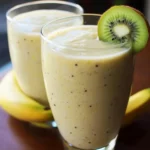Ingredients
- Fresh Kiwis: 2 medium, ripe kiwis. Look for kiwis that yield slightly to gentle pressure, similar to a ripe peach or avocado. These will be sweeter and less acidic. Kiwis are the zesty heart of this smoothie, providing a wonderful tartness and a significant dose of Vitamin C. We’ll be peeling them to ensure a smooth texture.
- Ripe Banana: 1 medium, ripe banana. The riper the banana (think more brown spots!), the sweeter it will be, reducing or eliminating the need for additional sweeteners. Bananas lend a natural creaminess and sweetness, as well as a good serving of potassium. For an extra thick and frosty smoothie, you can use a frozen banana. Simply peel, slice, and freeze ripe bananas in a freezer-safe bag.
- Greek Yogurt (Optional but Recommended): 1/4 to 1/2 cup plain Greek yogurt. This adds a wonderful creamy texture, a protein boost, and a tangy counterpoint to the sweet fruits. If you prefer a dairy-free version, coconut yogurt or a plant-based protein powder can be substituted, or simply omit it.
- Liquid Base: 1/2 cup of your preferred milk. Options include:
- Dairy Milk: Whole, 2%, or skim milk all work well.
- Almond Milk: Unsweetened almond milk is a popular low-calorie choice.
- Soy Milk: Offers a good protein content.
- Oat Milk: Known for its creamy texture.
- Coconut Milk (from a carton): Adds a subtle tropical note.
- Water or Coconut Water: For a lighter, more hydrating smoothie. Adjust the amount based on your desired consistency.
- Sweetener (Optional): 1-2 teaspoons of honey, maple syrup, agave nectar, or a pitted Medjool date. This is entirely dependent on the ripeness of your fruit and your personal preference. Often, ripe bananas provide enough sweetness on their own.
- Ice Cubes (Optional): 3-5 ice cubes. If you’re not using frozen banana, ice cubes will help make your smoothie cold and thick. If you are using frozen banana, you might not need any ice.
- Optional Boosters:
- Spinach or Kale: 1 small handful (about 1 cup, loosely packed). A fantastic way to sneak in extra greens! The taste is usually masked by the fruit.
- Chia Seeds or Flax Seeds: 1 tablespoon. For added fiber, omega-3 fatty acids, and a thicker texture.
- Protein Powder: 1 scoop of your favorite plain or vanilla protein powder for an extra protein punch, perfect for a post-workout refreshment.
- Vanilla Extract: 1/4 teaspoon for a hint of warm flavor.
- Lime or Lemon Juice: A tiny squeeze (about 1/2 teaspoon) can brighten the flavors even more.
Instructions
- Prepare the Fruits:
- Kiwis: Wash the kiwis thoroughly. Using a vegetable peeler or a small paring knife, carefully peel the fuzzy brown skin from both kiwis. Once peeled, roughly chop them into chunks. This makes them easier for the blender to process. The core of the kiwi is edible and nutritious, so there’s no need to remove it unless you prefer.
- Banana: Peel the ripe banana. If it’s a large banana, you might want to break it into a few smaller pieces before adding it to the blender. If using a frozen banana, it should already be peeled and possibly sliced.
- Load the Blender:
- It’s generally recommended to add ingredients to the blender in a specific order for optimal blending, especially if your blender isn’t high-powered. Start with the liquid base: pour your chosen milk (or water/coconut water) into the blender jug first. This helps the blades move more freely when you start blending.
- Next, add the softer ingredients. Add the chopped kiwis and the banana pieces.
- If you’re using Greek yogurt, spoon it in now.
- If you’re including any optional boosters like spinach, chia seeds, flax seeds, or protein powder, add them at this stage. Spinach should go in before the frozen elements if you’re using it.
- Add Sweetener and Ice (If Using):
- If you’ve decided to use a sweetener (honey, maple syrup, etc.), drizzle it in.
- Finally, if you’re using ice cubes (and not a frozen banana, or if you want it extra icy), add them on top of the other ingredients.
- Blend to Perfection:
- Secure the lid tightly on the blender.
- Start blending on a low speed for about 10-15 seconds to break down the larger pieces. This prevents splashing and helps the ingredients combine more easily.
- Increase the speed to high and blend for another 30-60 seconds, or until the smoothie is completely smooth, creamy, and there are no remaining chunks of fruit or ice. If you’ve added spinach, ensure it’s fully incorporated and the smoothie has a uniform green color.
- You may need to stop the blender once or twice to scrape down the sides with a spatula if ingredients are sticking, ensuring everything gets evenly blended. Be sure to turn off the blender before doing this.
- Check Consistency and Taste:
- Once blended, pour a small amount into a glass or taste it directly from the blender (carefully!).
- Consistency: If the smoothie is too thick for your liking, add a little more liquid (milk, water) a tablespoon at a time and blend briefly. If it’s too thin, you can add a few more ice cubes, a bit more frozen banana (if you have it), or a tablespoon of chia seeds (let it sit for 5 minutes to thicken).
- Sweetness: If it’s not sweet enough, add a little more of your chosen sweetener and blend again for a few seconds.
- Serve Immediately:
- Pour the freshly blended Kiwi Banana Smoothie into a tall glass.
- Garnish if desired (see “How to Serve” section for ideas).
- Enjoy your delicious and healthy creation right away for the best taste and texture.
Nutrition
- Serving Size: One Normal Portion
- Calories: 280-350
